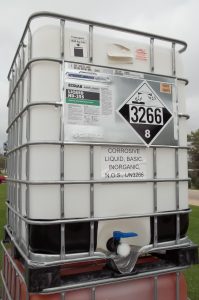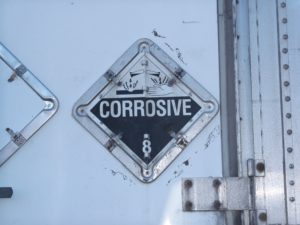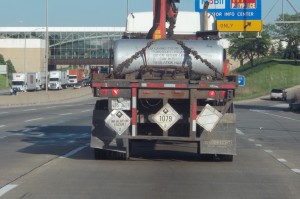A question (09.22.17):
if you are carrying 2 – totes of sulfuric acid on flatbed rail side truck and the totes are placarded correctly with the un# bulk placards. Does the truck also have to be placarded with the same placards?
Contact me with any questions you may have about the transportation of hazardous materials by air, highway, vessel, or rail International and Domestic Daniels Training Services, Inc. 815.821.1550 |
My answer:
The answer to your question is yes, the truck must display the required placards in addition to those on the totes if by “tote” you mean an intermediate bulk container or IBC and not a portable tank as your subject line indicates. Please see below.
- 49 CFR 172.504(a) requires a transport vehicle to display placards on all four sides (i.e. each side and each end) unless the type and quantity of HazMat is excepted from placarding requirements. This is not the case in your scenario.
- 49 CFR 172.516(a) requires the placards on a vehicle to be clearly visible and allows the required display of placards to be replaced by their display on a freight container or portable tank. An IBC is not indicated as an option for this exception.
- 49 CFR 171.8 defines a freight container: Freight container means a reusable container having a volume of 64 cubic feet or more, designed and constructed to permit being lifted with its contents intact and intended primarily for containment of packages (in unit form) during transportation.
- 49 CFR 171.8 defines a portable tank: Portable tank means a bulk packaging (except a cylinder having a water capacity of 1000 pounds or less) designed primarily to be loaded onto, or on, or temporarily attached to a transport vehicle or ship and equipped with skids, mountings, or accessories to facilitate handling of the tank by mechanical means. It does not include a cargo tank, tank car, multi-unit tank car tank, or trailer carrying 3AX, 3AAX, or 3T cylinders.
- 49 CFR 171.8 specifically defines an IBC as not a portable tank.
Like this article? Subscribe to my Monthly Newsletter No marketing emails! |
In sum:
 The display of placards and package marks (the 4-digit identification number) on the tote (aka: IBC) does not fulfill the requirement to display placards on all four sides of the vehicle.
The display of placards and package marks (the 4-digit identification number) on the tote (aka: IBC) does not fulfill the requirement to display placards on all four sides of the vehicle.
Conclusion:
I receive questions like this all the time. Sometimes – like this one – I’m surprised by the answer. Make sure you know the regulations before you ship and risk a fine. Contact me with your questions.

